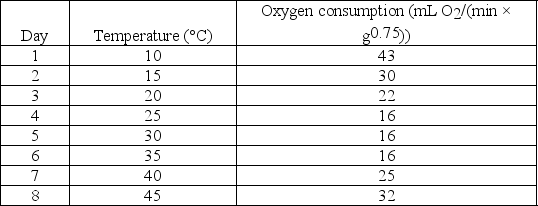Multiple Choice
Scenario
To study the effect of ambient (environmental) temperature on the metabolic rate of animals, a scientist takes a small animal and puts it in a sealed chamber with oxygen. The scientist measures the amount of oxygen used by the animal at different temperatures, as oxygen is consumed during the process of cellular respiration. The temperatures selected are those that the animal normally encounters in nature. The data from this experiment are in the table below.

-To communicate the results of the experiment best, how should the scientist graph the data?
A) Use a bar graph with oxygen consumption on the x-axis and temperature on the y-axis.
B) Use a line graph with day on the x-axis and temperature on the y-axis.
C) Use a line graph with temperature on the x-axis and oxygen consumption on the y-axis.
D) Use a bar graph with temperature on the x-axis and oxygen consumption on the y-axis.
Correct Answer:

Verified
Correct Answer:
Verified
Q6: When body temperature is too low, what
Q7: The urinary system is responsible for the
Q8: Which is the most abundant kind of
Q9: <b>Scenario</b><br>The dune-burrowing spider Seothyra species lives in
Q10: Excretion is the movement of substances from
Q12: <img src="https://d2lvgg3v3hfg70.cloudfront.net/TB7803/.jpg" alt=" -How will the
Q13: In a person suffering from heat stroke,
Q14: A main function of most types of
Q15: A physiologist is a biologist who studies
Q16: Which statement applies to freshwater fish?<br>A)They lose